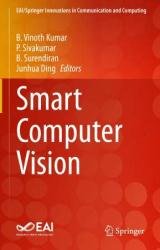Smart Computer Vision
- Добавил: literator
- Дата: 28-02-2023, 15:08
- Комментариев: 0
 Название: Smart Computer Vision
Название: Smart Computer VisionАвтор: B. Vinoth Kumar, P. Sivakumar, B. Surendiran
Издательство: Springer
Год: 2023
Страниц: 358
Язык: английский
Формат: pdf (true)
Размер: 11.8 MB
This book addresses and disseminates research and development in the applications of intelligent techniques for Computer Vision, the field that works on enabling computers to see, identify, and process images in the same way that human vision does, and then providing appropriate output. The book provides contributions which include theory, case studies, and intelligent techniques pertaining to Computer Vision applications. The book helps readers grasp the essence of the recent advances in this complex field. The audience includes researchers, professionals, practitioners, and students from academia and industry who work in this interdisciplinary field. The authors aim to inspire future research both from theoretical and practical viewpoints to spur further advances in the field.
Computer Vision is a field of Computer Science that works on enabling computers to see, identify, and process images in the same way that human vision does, and then provide appropriate output. It is like imparting human intelligence and instincts to a computer. It is an interdisciplinary field that trains computers to interpret and understand the visual world from digital images and videos. The main objective of this edited book is to address and disseminate state-of-the-art research and development in the applications of intelligent techniques for Computer Vision. This book provides contributions which include theory, case studies, and intelligent techniques pertaining to the computer vision applications.
A brief introduction to each chapter is as follows:
Chapter 1 discusses the Machine Learning approaches applied to automatic sports video summarization.
Chapter 2 proposes a new technique for lecture video segmentation and key frame extraction. The results are compared against six existing state-of-the-art techniques based on computational time and shot transitions.
Chapter 3 presents a system to detect the potholes in the pathways/roadways using Machine Learning and Deep Learning approaches. It uses HOG (histogram
of oriented gradients) and LBP (local binary pattern) features to enhance the classification algorithms performance.
Chapter 4 aims to explore various feature extraction techniques and shape detection approaches required for image retrieval. It also discusses the real-time applications of shape feature extraction and object recognition techniques with examples.
Chapter 5 describes an approach for texture image classification based on Gray Level Co-occurrence Matrix (GLCM) features and Machine Learning algorithm.
Chapter 6 presents an overview of unimodal and multimodal affective computing. It also discusses the various Machine Learning and Deep Learning techniques for affect recognition.
Chapter 7 proposes a Deep Learning model for content-based image retrieval. It uses K-Means clustering algorithm and Hamming distance for faster
retrieval of the image.
Chapter 8 provides a bio-inspired convolutional neural network (CNN)-based model for COVID-19 diagnosis. A cuckoo search algorithm is used to improve the performance of the CNN model.
Chapter 9 presents convolutional CapsNet for detecting COVID-19 disease using chest X-ray images.
Chapter 10 proposes a Deep Learning framework for an automated hand gesture recognition system.
Chapter 11 presents a new hierarchical Deep Learning based approach for semantic segmentation of 3D point cloud.
Chapter 12 summarizes that the proposed model acts as a better automatic colorization for colored and grayscale images without human intervention.
Chapter 13 proposes a generative adversarial network (GAN) for hyperspectral image classification.
Chapter 14 presents a brief introduction about the methodologies used for identifying diabetic retinopathy. It also uses convolutional neural network models to achieve an effective classification for diabetic detection of retinal fundus images.
Chapter 15 proposes a modified differential evolution (DE), best neighborhood DE(BNDE), to solve discrete-valued benchmarking and real-world optimization problems. The proposed algorithm increases the exploitation and exploration capabilities of the DE and to reach the optimal solution faster. In addition, the proposed algorithm is applied to grayscale image enhancement.
Chapter 16 presents an overview of the main swarm-based solutions proposed to solve problems related to Computer Vision. It presents a brief description of the principles behind swarm algorithms, as well as the basic operations of swarm methods that have been applied in Computer Vision.
Скачать Smart Computer Vision
[related-news] [/related-news]
Внимание
Уважаемый посетитель, Вы зашли на сайт как незарегистрированный пользователь.
Мы рекомендуем Вам зарегистрироваться либо войти на сайт под своим именем.
Уважаемый посетитель, Вы зашли на сайт как незарегистрированный пользователь.
Мы рекомендуем Вам зарегистрироваться либо войти на сайт под своим именем.
